The compact car segment is a battleground of practicality, innovation, and style, and two formidable contenders are the Fiat Panda and Hyundai i10. In this comparison, we delve into the technical aspects and innovations that define these small hatchbacks, helping consumers make informed choices.
Fiat Panda vs Hyundai i10 – Which one offers the better deal?
Both models have their strengths – but which one suits you more?
Compare performance, efficiency, price and space directly: Fiat Panda or Hyundai i10?
Design and Dimensions
Starting with dimensions, the Fiat Panda measures 3653 mm in length, while the Hyundai i10 is slightly longer at 3670-3675 mm. Width-wise, the Panda stands at 1643 mm, compared to the i10's 1680 mm, which contributes to the latter’s spacious interior feel. Both cars boast a 5-door hatchback design suitable for urban driving, but the i10's height of 1480-1483 mm compared to the Panda’s 1551 mm provides a sportier profile.
Engine Options and Performance
The Fiat Panda features a petrol MHEV engine that delivers 70 HP with a torque of 92 Nm, allowing acceleration from 0 to 100 km/h in 13.9 seconds. It’s offered exclusively with a manual gearbox and a front-wheel-drive system, focusing on efficiency and simplicity with a fuel consumption of 5-5.1 L/100km.
On the other hand, the Hyundai i10 provides several engine options, ranging from 63 HP to a peppy 90 HP variant. Its acceleration times vary significantly; for instance, the higher-powered version can go from 0 to 100 km/h in just 11.4 seconds, making it one of the quicker options in its class. The i10 also offers both manual and automated manual transmissions, giving drivers more flexibility. Fuel efficiency ranges from 4.9 to 5.4 L/100km, depending on the chosen engine.
Interior Comfort and Technology
When it comes to interior comfort, both models provide spacious environments ideal for city driving. The Fiat Panda seats up to five passengers with a trunk capacity of 225 liters, relatively adequate for day-to-day needs. Conversely, the Hyundai i10 enhances its practicality with a larger trunk capacity of 252 liters, making it a better option for those who need additional storage space.
Technological features vary, with the Hyundai i10 typically being more equipped with modern infotainment systems and safety features. The availability of touchscreen displays, navigation systems, and advanced driver-assistance technologies gives it a slight edge over the Panda, which is more traditional in its approach.
Fuel Efficiency and Emissions
Fuel efficiency is a critical factor when considering compact cars. The Panda's CO2 emissions range between 113-116 g/km, placing it in a reasonable efficiency bracket. The Hyundai i10 matches this with emissions between 111-123 g/km, depending on the engine option selected. Both vehicles earn ratings in the C and D efficiency classes, catering to environmentally conscious drivers.
Conclusion: Which One to Choose?
Ultimately, the choice between the Fiat Panda and Hyundai i10 boils down to personal preferences and driving needs. The Panda appeals with its distinctive character and robust design, especially for those who value simplicity and efficiency. Meanwhile, the Hyundai i10 excels in technology, interior space, and performance, making it a great pick for drivers who seek a versatile urban companion.
Whichever model you choose, both cars are excellent representatives of the compact segment, providing a blend of comfort, practicality, and efficiency that suits the demands of modern-day city driving.
Here’s where it gets real: The technical differences in detail
Costs and Efficiency:
When it comes to price and running costs, the biggest differences usually appear. This is often where you see which car fits your budget better in the long run.
Fiat Panda has a slight advantage in terms of price – it starts at 14100 £, while the Hyundai i10 costs 14600 £. That’s a price difference of around 428 £.
Fuel consumption also shows a difference: Hyundai i10 manages with 4.90 L and is therefore barely noticeable more efficient than the Fiat Panda with 5 L. The difference is about 0.10 L per 100 km.
Engine and Performance:
Power, torque and acceleration are the classic benchmarks for car enthusiasts – and here, some clear differences start to show.
When it comes to engine power, the Hyundai i10 has a distinct edge – offering 90 HP compared to 70 HP. That’s roughly 20 HP more horsepower.
In acceleration from 0 to 100 km/h, the Hyundai i10 is evident quicker – completing the sprint in 11.40 s, while the Fiat Panda takes 13.90 s. That’s about 2.50 s faster.
In terms of top speed, the Hyundai i10 performs hardly perceptible better – reaching 175 km/h, while the Fiat Panda tops out at 164 km/h. The difference is around 11 km/h.
There’s also a difference in torque: Hyundai i10 pulls significantly stronger with 172 Nm compared to 92 Nm. That’s about 80 Nm difference.
Space and Everyday Use:
Cabin size, boot volume and payload all play a role in everyday practicality. Here, comfort and flexibility make the difference.
Seats: Hyundai i10 offers slightly more seating capacity – 5 vs 4.
In curb weight, Hyundai i10 is slight lighter – 996 kg compared to 1055 kg. The difference is around 59 kg.
In terms of boot space, the Hyundai i10 offers somewhat more room – 252 L compared to 225 L. That’s a difference of about 27 L.
In maximum load capacity, the Hyundai i10 performs a bit better – up to 1050 L, which is about 180 L more than the Fiat Panda.
When it comes to payload, Hyundai i10 somewhat takes the win – 423 kg compared to 365 kg. That’s a difference of about 58 kg.
Who comes out on top?
Overall, the Hyundai i10 shows itself to be is largely superior and secures the title of DriveDuel Champion.
It convinces with the more balanced overall package and proves to be the more versatile choice for everyday use.
 @ Hyundai Motor Company
@ Hyundai Motor Company
Hyundai i10
Fiat Panda
The Fiat Panda is a compact city car that brilliantly combines practical design and efficient functionality. Its boxy shape provides ample interior space and visibility, making it a favourite among urban drivers. With its reputation for reliability and affordability, the Panda continues to be a top choice for those seeking a no-frills, dependable vehicle.
details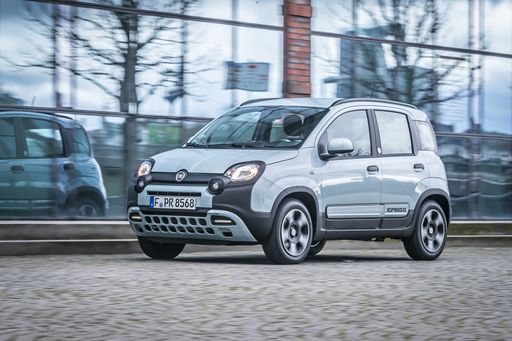 @ Fiat / Stellantis Media
@ Fiat / Stellantis Media
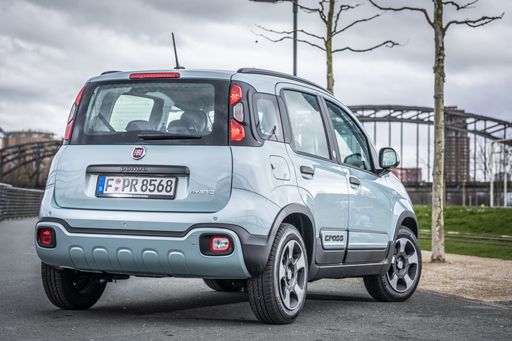 @ Fiat / Stellantis Media
@ Fiat / Stellantis Media
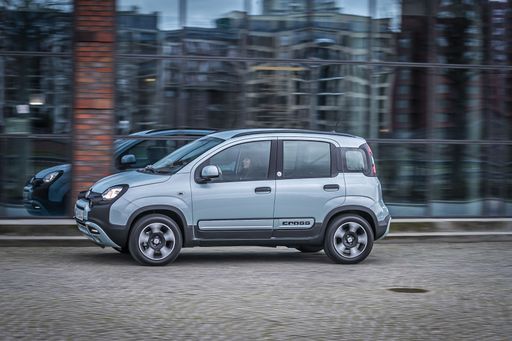 @ Fiat / Stellantis Media
@ Fiat / Stellantis Media
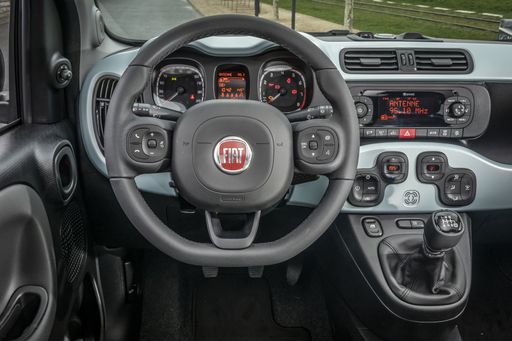 @ Fiat / Stellantis Media
@ Fiat / Stellantis Media
Hyundai i10
The Hyundai i10 impresses with its compact design, making it an ideal choice for navigating through busy urban environments. Its interior is surprisingly spacious, offering drivers and passengers comfort beyond what one might expect from a city car. The model combines efficiency and practicality, making it an attractive option for those seeking both economy and functionality in their daily commute.
details @ Hyundai Motor Company
@ Hyundai Motor Company
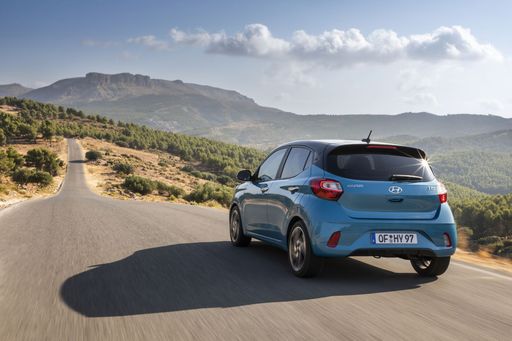 @ Hyundai Motor Company
@ Hyundai Motor Company
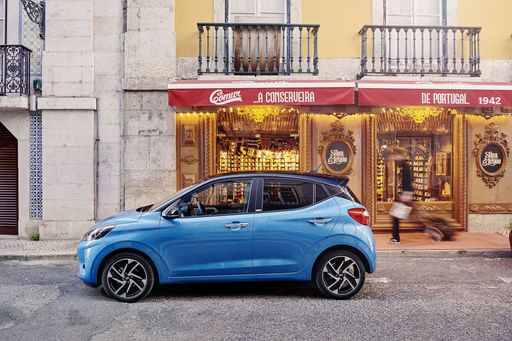 @ Hyundai Motor Company
@ Hyundai Motor Company
 @ Hyundai Motor Company
@ Hyundai Motor Company
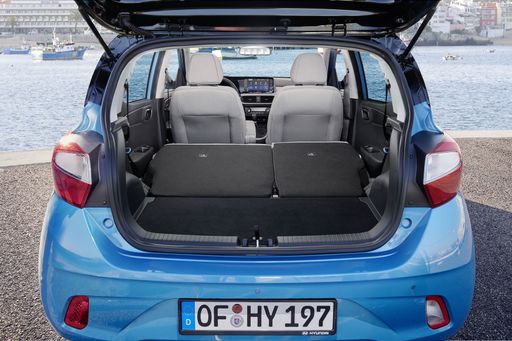 @ Hyundai Motor Company
@ Hyundai Motor Company
 @ Fiat / Stellantis Media
@ Fiat / Stellantis Media
|
 @ Hyundai Motor Company
@ Hyundai Motor Company
|
|
|
|
Costs and Consumption |
|
|---|---|
|
Price
14100 £
|
Price
14600 - 19000 £
|
|
Consumption L/100km
5 L
|
Consumption L/100km
4.9 - 5.5 L
|
|
Consumption kWh/100km
-
|
Consumption kWh/100km
-
|
|
Electric Range
-
|
Electric Range
-
|
|
Battery Capacity
-
|
Battery Capacity
-
|
|
co2
113 g/km
|
co2
110 - 124 g/km
|
|
Fuel tank capacity
38 L
|
Fuel tank capacity
36 L
|
Dimensions and Body |
|
|---|---|
|
Body Type
Hatchback
|
Body Type
Hatchback
|
|
Seats
4
|
Seats
4 - 5
|
|
Doors
5
|
Doors
5
|
|
Curb weight
1055 kg
|
Curb weight
996 - 1099 kg
|
|
Trunk capacity
225 L
|
Trunk capacity
252 L
|
|
Length
3635 mm
|
Length
3670 - 3675 mm
|
|
Width
1643 mm
|
Width
1680 mm
|
|
Height
1551 mm
|
Height
1480 - 1483 mm
|
|
Max trunk capacity
870 L
|
Max trunk capacity
1050 L
|
|
Payload
365 kg
|
Payload
344 - 423 kg
|
Engine and Performance |
|
|---|---|
|
Engine Type
Petrol MHEV
|
Engine Type
Petrol
|
|
Transmission
Manuel
|
Transmission
Manuel, Automatic
|
|
Transmission Detail
Manual Gearbox
|
Transmission Detail
Manual Gearbox, Automated Manual
|
|
Drive Type
Front-Wheel Drive
|
Drive Type
Front-Wheel Drive
|
|
Power HP
70 HP
|
Power HP
63 - 90 HP
|
|
Acceleration 0-100km/h
13.90 s
|
Acceleration 0-100km/h
11.4 - 18.4 s
|
|
Max Speed
164 km/h
|
Max Speed
143 - 175 km/h
|
|
Torque
92 Nm
|
Torque
93 - 172 Nm
|
|
Number of Cylinders
3
|
Number of Cylinders
3 - 4
|
|
Power kW
51 kW
|
Power kW
46 - 66 kW
|
|
Engine capacity
999 cm3
|
Engine capacity
998 - 1197 cm3
|
General |
|
|---|---|
|
Model Year
2024
|
Model Year
2024
|
|
CO2 Efficiency Class
C
|
CO2 Efficiency Class
C, D
|
|
Brand
Fiat
|
Brand
Hyundai
|
Is the Fiat Panda offered with different drivetrains?
Available configurations include Front-Wheel Drive.
The prices and data displayed are estimates based on German list prices and may vary by country. This information is not legally binding.
